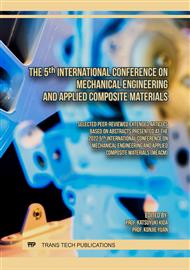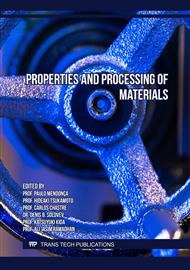[1]
P. H. Frith, Fatigue Tests on Rolled Alloy Steels Made in Electric and Open-Hearth Furnaces, Journal of The Iron and Steel Institute, Vol. 180, pp.26-33, (1955).
Google Scholar
[2]
K. Shiozawa, Y. Morii, S. Nishino and L. Lu, Subsurface crack initiation and propagation mechanism in high-strength steel in a very high cycle fatigue regime, International Journal of Fatigue, 28, pp.1521-1532, (2006).
DOI: 10.1016/j.ijfatigue.2005.08.015
Google Scholar
[3]
Y. Murakami, Metal fatigue: Effects of Defects and Nonmetallic Inclusions, Elsevier Science Ltd, UK, (2002).
Google Scholar
[4]
T. Sakai, Y. Sato, Y. Nagano, M. Takeda and N. Oguma, Effect of stress ratio on long life fatigue behavior of high carbon chromium bearing steel under axial loading, International Journal of Fatigue, 28, pp.1547-1554, (2006).
DOI: 10.1016/j.ijfatigue.2005.04.018
Google Scholar
[5]
S. Shiko, K. Okamoto and S. Watanabe, Effect of Metallographical Factors on the Rolling Fatigue Life of Ball Bearing Steel, Tetsu-to-Hagane, Vol. 54, No. 13, pp.1353-1366, (1968) (in Japanese).
DOI: 10.2355/tetsutohagane1955.54.13_1353
Google Scholar
[6]
E. Yajima, T. Miyazaki, T. Sugiyama and H. Terajima, Metallographic Investigations on Rolling Fatigue Life of Ball Bearing Steel and Effects of Retained Austenite on the Fatigue Life, Journal of The Japan Institute of Metals, Vol. 36, No. 7, pp.711-719, (1972) (in Japanese).
DOI: 10.2320/jinstmet1952.36.7_711
Google Scholar
[7]
R. A. Grange, E. R. Shackelford, U. S. Patent 3,178,324, (1965).
Google Scholar
[8]
R. A. Grange, The Rapid Heat Treatment of Steel, Merallurgical Transactions, Vol. 2, pp.65-78, (1971).
Google Scholar
[9]
H. Koike, E. C. Santos, K. Kida T. Honda and J. Rozwadowska, Effect of repeated induction heating on fatigue crack propagation in SAE 52100 bearing steel, Advanced Materials Research, Vols. 217-218, pp.1266-1271, (2011).
DOI: 10.4028/www.scientific.net/amr.217-218.1266
Google Scholar
[10]
I. Yoshida, K. Mizobe and K. Kida, Observation of Fracture Surface of Induction-Heated JIS SUJ2 Bearing Steel under Rotating Bending Fatigue, ISSN: 1662-9752, Vol. 904 pp.24-28, (2017).
DOI: 10.4028/www.scientific.net/msf.904.24
Google Scholar
[11]
K. Mizobe, E. C. Santos, T. Honda, H. Koike and K. Kida, Observation of non-metallic inclusions on repeatedly quenched SAE 52100 bearing steel fracture surfaces, International Jornal of Materials and Product Technology, Vol. 44, pp.227-239, (2012).
DOI: 10.1504/ijmpt.2012.050186
Google Scholar
[12]
T. Matsueda, K. Ushizima, K. Mizobe and K. Kida, Characterization of Crack Growth Behavior of Carburized SCM415 Steel under Cyclic Rotating Bending, Solid State Phenomena, Vol. 298, pp.13-18, (2019).
DOI: 10.4028/www.scientific.net/ssp.298.13
Google Scholar



